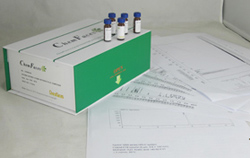Hot Products



| Catalog No. | Information |
| CFN93368 | Escin IA Escin IA is a prodrug and its structure can be converted to desacylescin I by human intestinal bacteria and Lactobacillus brevis., desacylescin I as a biotransformation product shows potentially inhibitory effects on mouse tumor, and a potential candidate for anti tumor agents. Escin IA has anti-TNBC metastasis activity, and its action mechanisms involved inhibition of EMT process by down-regulating LOXL2 expression. |
| CFN90934 | Escin IB Escin Ib inhibits gastric emptying, at least in part, mediated by capsaicin-sensitive sensory nerves, to stimulate the synthesis and/or release of dopamine, to act through central dopamine2 receptor, which in turn causes the release of PGs. |
| CFN99059 | Esculentic acid Esculentic acid has anti-inflammatory effect, it has protective effects against LPS-induced endotoxic shock may be mediated, at least in part, by regulation the release of inflammatory cytokines and mediators, and protein expression of COX-2 in mice. |
| CFN98162 | Esculentoside A Esculentoside A has anti-inflammatory activity , can suppress inflammatory responses in LPS-induced ALI through inhibition of the nuclear factor kappa B and mitogen activated protein kinase signaling pathways. Esculentoside A may be useful for the treatment of autoimmune disease through modulation on T cell-mediated adaptive immunity. Esculentoside A treatment can attenuate CCl4 and GalN/LPS-induced acute liver injury in mice. |
| CFN98163 | Esculentoside B Phytolaccoside B(Esculentoside B) is an antifungal monodesmoside triterpenoid glycoside, it has potent inhibitory activity against agrobacterial plant transformation. |
| CFN98164 | Esculentoside C Esculentoside C exerts proinflammatory effects synergistically, it can induce inflammatory stimulation. |
| CFN90657 | Esculentoside H Phytolaccaceae has anti-tumor activity, the mechanism may be related to the capacity of Esculentoside H for TNF release. |
| CFN99114 | Esculin Esculin has neuroprotective, anti-oxidative, and anti-apoptotic effects, it is a plant coumarin compound that occur naturally in dietary plants or when supplemented in the diet probably inhibit the survival of E. coli O157 in the gut. Esculin has protective effects on dopamine(DA)-induced cytotoxicity in human neuroblastoma SH-SY5Y cells. Esculin has a protective effect on lipopolysaccharide (LPS)-induced acute lung injury (ALI) in mice, it can inhibit the Toll-like receptor-2 (TLR2), Toll-like receptor-4 (TLR4), myeloid differentiation primary response gene-88 (MyD88), and nuclear factor-κB (NF-κB) p65 in LPS-induced ALI. |
| CFN70065 | Estragole Estragole, a naturally occurring flavoring agent, has hepatocarcinogenicity, and mutagenicity. It also has insecticidal activity.Estragole has cardiovascular effects. |
| CFN90079 | Estriol Estriol (E3), an endogenous estrogen predominantly produced during human pregnancy, is an antagonist of the G-protein coupled estrogen receptor in estrogen receptor-negative breast cancer cells. E3 can blunt the postprandial glycemic surge in rats through modulating the level of intestinal glucose transporters. E3 exerts a mitogenic effect on T-47D and MCF-7 cells at concentrations of 10(-9)M (288 pg/ml) and higher. |